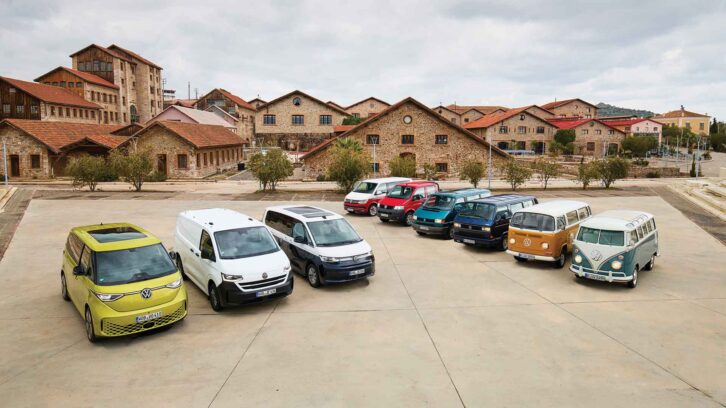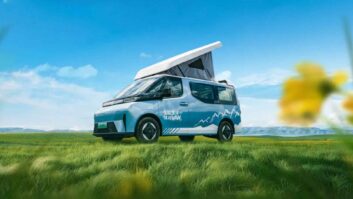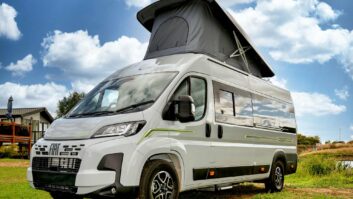I don’t know about you, but most people seem utterly baffled by the future of motoring in the UK and what it means for electric campervans. Government tinkering with the Zero Emission Vehicle deadlines for electric vehicles hasn’t helped.
The automotive industry has had to deal with the erratic nature of these back-and-forth decisions and it’s now little wonder that most consumers’ heads are spinning.
The UK’s original timeline was to transition to a ban on the sale of new fossil fuel vehicles by 2030, in line with the EU-wide goal – set by the Paris Agreement – of reaching net zero for carbon emissions by 2050.
Rishi Sunak then moved it forward to 2035, before Keir Starmer pledged to bring it back to 2030.
The aim is for new vehicles powered only by fossil fuel to be phased out by 2030, with the sale of new hybrid fossil fuel vehicles allowed until 2035. After pushback from the manufacturers over bringing the date to the original 2030, a consultation is taking place over the timing. As I write this, the deadline is still set at 2035.
According to a recent AA survey of 14,000 UK motorists, 7% of people believe that this ban affects the sale of used fossil fuel vehicles. This is incorrect so there’s no need to rush out and start thinking about selling your motorhome – used fossil fuel vehicles can still be bought and sold after the ban, and you can expect to see fossil fuel-powered vehicles on our roads for at least another 50 years or so. Fuel companies have committed to providing fuel for them.
Consequently, it is highly likely that new businesses will spring up, offering to recondition fossil fuel vehicles to ‘as new’ condition, if there is a suitable level of demand for them.
The same thing has started to happen with electric vehicle (EV) battery recycling firms. Replacing a battery pack is now far cheaper and costs a similar amount to replacing a vehicle engine.
So is it time to go electric? Let’s take a look.
Electric campervans: what you need to know
Are EVs greener?
Do they depreciate more?
Can you have a 7kW charger?
Living with an EV
The upsides of going electric
Downsides to EVs
Choose your route wisely!
Can I recharge on a campsite?
What about hydrogen cells?
Synthetic or electrofuels
Are EVs greener?
According to the Carbon Majors website, which monitors emissions, half of the world’s carbon emissions in 2023 were produced by just 36 businesses.
All of these are fossil fuel companies. Saudi Arabia’s Aramco is the world’s largest CO2 emitter, closely followed by Coal India, CHN Energy (China), NIOC (Iran) and the Jinneng Group (China).
The US companies ExxonMobil and Chevron are also heavy CO2 emitters, followed by Shell (UK), TotalEnergies (France) and BP (UK).
CO2 emissions have been rising since the industrial revolution and started to skyrocket from the sixties onwards. The world produced around 10,000 million tonnes of CO2 in 1960 and over 35,000 million tonnes by 2020.
The ice record provides damning evidence of this trend – layers of ice formed over thousands of years capture tiny bubbles of atmosphere that allow scientists to analyse how it has changed over time. And the science is clear: to prevent more global extreme weather events and restabilise the climate, we need to cut our carbon emissions.
Vehicles are one way to do this, but EVs’ tailpipe-free emissions have to be balanced against how the energy is created in the first place (coal-powered generation simply shifts the point at which the pollution occurs), as well as the energy and materials used in building the vehicle itself.
Much is being made of the harm caused by the materials mined to produce EV batteries – such as lithium, cobalt, nickel, manganese, copper and aluminium – but most of these can be recycled at the end of use, so the situation is not quite as clear-cut as you might first think.
The move to solid-state batteries looks likely to help here.

Once again, the science is pretty clear – if you do 100,000 miles in an EV, the net CO2 lifecycle emissions (including generation of electricity, energy in use and materials used in manufacture) will be lower than those of a fossil fuel powered vehicle.
The lack of tailpipe emissions can also be of benefit in tackling high levels of air pollution in city centres.
Government figures state that on average, an EV’s lifecycle emissions will be better than a fossil fuel vehicle’s after three years of use. This is based on average mileage of around 6000 miles.
Other studies have shown that for lower mileages, the lifecycle emission improvement compared to a fossil fuel can take a lot longer. If you only cover 2000 miles a year, the CO2 reduction compared to using a fossil fuel vehicle can take over 15 years to add up.
Clearly, those people who swap their vehicle every three to five years and do low mileage would be better off buying a fossil fuel vehicle. So the EVs and reduced emissions argument is not as clear-cut as you might think.
Do they depreciate more?
According to some in the media, EVs depreciate like stones. The reality is that all new vehicles depreciate and if you look at the top 10 depreciating vehicles in the UK (according to the SMMT), most are fossil fuel powered.
So what about if you’re thinking of selling a motorhome that is an EV? Leisure vehicles tend to buck the trend, by not depreciating so much. How electric campervan residuals will compare to fossil fuel vehicles is unclear, however, owing to the lack of data.
Generally speaking, EV purchases are on the rise, with oil demand falling. In addition, given the expansion of Low Emission Zones in cities – which in many cases, only EVs comply with – it is likely that EV use will rise.
Can you have a 7kW charger?
For the past eight months, my wife Helen has had an EV as her daily driver and it tends to get used as the family car at weekends, too.
This has given us great insight into how the electric transition actually works in practice.
When we bought the car, we didn’t have a 7kW charger fitted at home and had to top up the battery overnight on a regular three-pin socket. This didn’t work that well – it’s a bit like trying to fill a bathtub with a thimble!
A full charge of the 82kWh battery from flat would take around two days. Clearly if you’re using the car for work, this simply isn’t practical.
To fit the 7kW charger, you have your house professionally surveyed to check its suitability, then hire an electrician to install it. The electrical survey was free from our energy provider, while the Zappi charger cost around £800, and fitting was a further £200 from an electrician friend of ours (you can pay up to £1000 for fitting, depending on the distance from your consumer unit to where the charger is sited).

Some electricity providers offer deals with charging units and installations that are linked to favourable overnight tariff rates, so it’s worth doing your homework on that. You might find that you need to switch to a different provider to get a better rate.
The house survey is critical and while most new houses are being built with EV charging capability, this might not be the case with an older property.
If you don’t have sufficient electrical capacity to cope with a 7kW charger, you would need to have new cables installed to upgrade the wiring to the house from the supply – which can be prohibitively expensive.
If you can’t have a 7kW supply, an EV will simply not work well for you. This would be the deal-breaker.
Living with an EV
We opted to have a charger with a few fancy features included, such as energy monitoring and solar integration, that it turns out we don’t actually use – so with hindsight, a more basic £500 unit would have been fine.
The car itself sets the charge profile, so the charging unit is just a 7kW-rated power outlet. It is well worth getting a tethered charging point (one with a built-in cable), because this saves you having to retrieve the car’s charging cable from inside it and makes life that little bit easier. All we do is drive home and simply plug the car in.
Via the car’s app, it then recharges fully overnight to 90%, which is best for battery longevity – 100% is only needed for longer journeys.

We have only made use of one public charging station in those eight months, and the car typically costs us £30-£60 in electricity per month to do around 5000 miles a year.
By comparison, fossil fuel cars (which do around 8000 miles a year) cost about £600 per month.
This fuel saving has been the biggest bonus of going electric, but our car only does around 30 miles a day, with the occasional 200-mile round trip at the weekend, so it is ideally suited for the EV set-up. Not all leisure vehicles are going to be used this way, though.
Range anxiety hasn’t really been an issue, either – our Volvo can do about 200 miles, and you’d rarely ever want to drive for a solid three hours without a break, so topping it up at a coffee shop isn’t really a chore.
The upsides of going electric
The number one benefit for us has been the savings in fuel costs. Although for a longer journey, we’d probably still take a diesel vehicle, it’s the short trips where savings start to add up. Those sub-20-mile journeys we all tend to do at the weekends soon stack up when you’re paying £1.50 a litre for fuel.
By comparison, the EV feels almost naughty in how cheap it is to run. But that’s only because of the home 7kW charger. If you like occasional weekend jaunts away at a campsite that’s under 100 miles away, an EV will work well.

The other big plus is how pleasant they are to drive. No rattling diesel engine or pungent smells.
With fewer moving parts, EVs also have the potential to last longer and have lower running costs.
Replacing a battery costs no more than replacing an engine these days, so that argument is no longer valid – batteries are already outlasting their predicted lifespans.
Downsides to EVs
The two downsides that most people cite are always the same: range and the charging network.
A range of around 200 miles isn’t an issue – at 70mph, this would mean you’re driving for almost three hours without a break. Who does that? It’s natural to stop for a break. And with a fast charger, they can be topped up in as little as half an hour.
Route planning becomes a key part of owning an EV and vehicles with built-in sat nav that automatically plots a route via the charging network make this easy. There are lots of apps to track down charging points, such as Zapmap, so you’re rarely going to be that far from a charger.
At the end of February 2025, there were 75,675 public charging points across the UK, with an estimated 850,000 home/workplace chargers, according to Zapmap. However, the bulk of these are under 8kW, with only around a third being the more powerful units that allow more rapid recharge.
Obviously, during peak times – such as a drive to Cornwall in July – the most popular tourist routes are going to have the busiest chargers. I have queued for petrol stations in the south-west in high summer, so this is nothing new.
However, it’s not the vehicle range or the availability of charging points that is the key issue for EV drivers – it’s the cost of public charging.

At home on a cheap-rate tariff, you might pay as little as 7p per kWh (about 2p per mile), while on a public charger it’s typical to pay 80p per kWh (about 25p per mile).
In practice, the cost of recharging an EV at a public charging point works out similar to that of refuelling a fossil fuel vehicle, or slightly cheaper. It’s not a reason to buy one – home charging is the key to savings.
The range of an EV diminishes with the temperature of the battery, just as it does with a campervan leisure battery – so in the winter months, you have reduced capacity.
To get around this, manufacturers fit warming devices to EVs that prewarm the battery and cab before unhooking from the charging cable. But even then, the range is still lower in winter.
In summer, our Volvo XC40 will do 200 miles on a full charge, but in the winter, this drops to 160 miles. The difference in range is large in vehicles lacking battery heating systems.
For longer journeys, an EV might not be the best choice, simply because having to make more frequent stops for recharging can quickly eat into your precious holiday time.
The other major issue with EVs comes down to motorhome weights and what it means for the driving licence you need to drive a motorhome.
Motorhome brands are already struggling to get larger leisure vehicles under the 3500kg weight limit – so all drivers on a B category licence can drive them without needing a C1 licence, which can be a pain to renew if you’re over 70 – and fitting a huge battery bank doesn’t help.
There are moves afoot in Europe to increase the weight limit of a B licence to 4250kg – which the UK may mirror – but they’re not in place yet.
So installing a suitable battery bank in a Ducato-sized motorhome, without saddling it with a miserly range, is still something of a challenge.
It’s no surprise, then, that small campervans (think Transporter-sized) work better, because they offer more payload relative to their total weight.
For those of you who are looking to lower the weight of your ‘van, don’t miss my tips on how to reduce the weight of a motorhome either – there are plenty of free things you can do yourself.
Choose your route wisely!
For a diesel vehicle, the route has a small influence on both economy and range. On a hilly journey, they use more fuel, and they are better driven at a constant speed on a motorway or A-road to minimise acceleration, which burns the most fuel.
If you drive an EV in the same way, you’ll be disappointed. EVs prefer the longer, hillier route over a shorter motorway blast at 70mph.
The range can vary dramatically, depending on your choice. It is directly proportional to the speed and the number of hills on the route.

Just dropping the speed to 65mph greatly increases range, while hills can really improve things, thanks to regenerative braking.
Heading downhill helps to recharge the battery and makes a real difference to range, while heading uphill at a constant speed doesn’t seem to make more difference to driving on the flat. EVs are unusual in this way.
If you simply drive an EV exactly the same way as a diesel, you’ll get poor results. Picking a different, hillier route and keeping the top speed down is the key to extending the range.
Can I recharge on a campsite?
So you’ve pitched up at one of the best motorhome sites – how can you charge your EV? You’d think that a field full of electric hook-up points, such as a campsite, would be the perfect place to recharge your electric campervan, but the problem is one of scale.
A normal 16A electric hook-up is like recharging an electric car at home on a three-pin plug. Yes, you can do it, but it will be glacially slow. Some sites do offer high-powered charging points for EVs, but they’re not widespread – many campsites simply don’t have the power to support a field full of EVs all charging at the same time.
Not all campsites will allow you to charge up on their premises, either – it’s down to individual policies.

The Caravan and Motorhome Club has 22kW chargers on eight of its sites (and 7kW chargers on four others), but these can’t be booked in advance.
It will allow you to charge an EV via three-pin socket in your motorhome (so plug the drivetrain lead into that) when you’re on a mains hook-up. This costs an extra £7 per night, which is pretty good value.
The Camping and Caravanning Club will also allow you to charge up an EV by plugging it into the three-pin socket in your leisure vehicle, at no charge.
No campsites let you plug an EV into the hook-up cable, to avoid damaging or overloading their electrics.
To recharge an EV fully from flat might take a couple of days on a regular hook-up. Bear in mind, though, that if you’re sharing the power between the EV and your habitation system, it could take longer – use of the heating system, lighting and cooking facilities will reduce the electricity available for recharging.
What about hydrogen cells?
In 2021, when I first wrote about EVs, there were 11 hydrogen refuelling points, mainly centred on London.
Today there are only seven, four in England (Swindon, Birmingham, Rotherham and London), one in Wales (Port Talbot) and two in Scotland (both in Aberdeen). Most of these use natural gas to create the hydrogen, making them use a fossil fuel as a byproduct of their production. This is because it’s cheaper to extract the hydrogen from gas than it is to generate it from the atmosphere, because of the substantial amounts of electricity that are needed.
In future, it’s hoped that hydrogen will be produced in the summertime from renewable sources, and that keeping it in reserve will offer a way of storing this energy for future use.
Element 2 is a company that is looking to distribute hydrogen around the UK produced by electrolysis in water treatment plants.
The challenge for hydrogen fuel is twofold: the lack of a nationwide distribution network, and the high use of electricity needed to produce it (which depends on the growth of renewable energy sources).

As we have an electricity network in place – which needs beefing up – and EVs’ battery range is increasing by about 5% per year, it seems unlikely that hydrogen fuel cell vehicles will take over the car market.
For heavier vehicles, such as RVs, motorhomes, trucks, aviation and shipping, hydrogen might well have a part to play. But bear in mind that all hydrogen fuel cell vehicles are essentially an EV with an extra energy production unit onboard. Newer and more energy-dense battery technology – such as solid-state units – might make hydrogen redundant.
At present, China leads the field in battery technology and they currently have two cars on sale in their home market with semi-solid-state batteries (which use a gel rather than a liquid).
The SAIC-owned IM Motors already sells the L6 saloon, which has a range of 621 miles, while the Nio ET7 saloon offers 650 miles of range, thanks to its semi-solid-state batteries.
European makers are soon to launch similar battery-powered vehicles and it’s simply a question of who will be first to market. A fully solid-state battery will offer even greater range.
Synthetic or electrofuels
Several scientific bodies have made the point that it’s all well and good to target new vehicles for emissions, but what about all the existing ones on the road? How can they be made greener?
This is a pertinent question, as there are far more used vehicles on European roads than new ones. Targeting them has potential for larger CO2 reduction. One method is to use a synthetic or electrofuel, also known as e-fuel.
Developed chemically, these differ from crop-based biofuels (for example, ethanol, which is added to current UK fossil fuels), in that they use carbon capture during manufacture.
Although they produce tailpipe emissions when the fuel is burned in a vehicle, production of the fuel itself helps to reduce total CO2 levels. So it’s far cleaner than burning a dug-up and refined fossil fuel.
The downside to synthetic fuel is currently the cost – 100% synthetic fuel is around three times the price of regular fuel. It’s not widely available and has to be bought by the barrel
from specialist suppliers.
The verdict on electric campervans
The lack of grants, higher tax costs and premium car tax changes have made EVs less financially appealing, and expensive public charging means they only make financial sense if you can charge at home on a 7kW charger.
If you live in a city and park on the street, public charging will be costly.
Although daily driven EVs work well, leisure vehicles tend to be used sporadically and often do longer single trips, with very different requirements.
Whether the reduced range of an electric campervan will work for you depends on the infrastructure en route and the charging facilities at the campsite.
In the long term, it’s clear that EVs have a place, but for now, diesel really does take some beating, especially in a larger motorhome. And if you do under 5000 miles a year, it could even be the greener choice for CO2 emissions.
Take a look at what I have to say about motorhome tyre pressure too – setting it correctly can be more complicated than you might think.
If you’ve enjoyed reading this article, why not get the latest news, reviews and features delivered direct to your door or inbox every month. Take advantage of our brilliant Practical Motorhome magazine SUBSCRIBERS’ OFFER and SIGN UP TO OUR NEWSLETTER for regular weekly updates on all things motorhome related.























